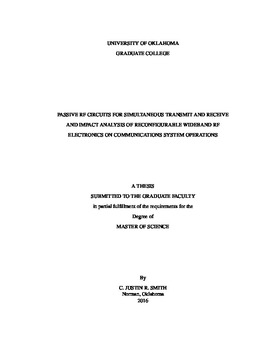| dc.contributor.advisor | Sigmarsson, Hjalti | |
| dc.contributor.author | Smith, C. Justin | |
| dc.date.accessioned | 2016-05-13T12:29:54Z | |
| dc.date.available | 2016-05-13T12:29:54Z | |
| dc.date.issued | 2016-05-18 | |
| dc.identifier.uri | https://hdl.handle.net/11244/34661 | |
| dc.description.abstract | Consumer based wireless systems currently operate with a split spectrum approach. However, in order to accommodate the increased demand for high datarate services within fixed spectrum allocations a new architecture will be required. The ability
to simultaneously transmit and receive data within the full spectrum allocation can alleviate this problem. Simultaneous transmission and reception within current spectrum limits could effectively double data rates. However, physical limitations
on radio frequency circuits including reflections and mutual coupling currently limit the capability of systems to operate in this mode. Therefore, radio frequency circuits that cancel this self-interference must be introduced.
This thesis describes the development of a self-interference cancellation circuit for simultaneous transmit and receive. The design operates by combining an out of phase signal of equal magnitude with the original self-interference signal. Design
methodology for the required radio frequency circuitry, including antenna elements, directional couplers, and hairpin resonators is provided. A characterization method for determining the antenna mutual coupling and phase characteristics is implemented
in commercial computer aided design software. Both a hairpin resonator and a delay line are used to match the phase and magnitude characteristics of the antenna mutual coupling. Directional couplers are designed to provide the required
anti-phasing of the signal and couple the required power level from the transmit path, through the phasing element, to the receive path. The devices are fabricated on high frequency printed circuit board materials and measured. The theory of
operation for a T-junction exponential power divider used in an early version of the circuit is also presented. Measured results of the self-interference cancellation circuit agree well with simulation.
Future RF systems are being designed with a desire for both simultaneous transmit and receive capability and wideband operation. However, due to the nature of wideband devices, they are susceptible to out-of-band interference degrading system level performance. With this in mind, a system level analysis of a wideband low noise amplifier with both adaptive and controllable biasing current is performed. Based on a quadrature phase shift keyed communications system, simulation
and measurements fundamental to the operation of such wideband devices are conducted. This analysis shows the dependence of in-band performance on power received from out-of-band interfering signals. It is shown that the out-of-band noise sources contribute to increased error vector magnitude in the receiver due to gain compression. | en_US |
| dc.language | en_US | en_US |
| dc.subject | RF and Microwave Engineering | en_US |
| dc.subject | Passive Devices | en_US |
| dc.subject | System Level Analysis | en_US |
| dc.subject | Simultaneous Transmit and Receive | en_US |
| dc.title | PASSIVE RF CIRCUITS FOR SIMULTANEOUS TRANSMIT AND RECEIVE AND IMPACT ANALYSIS OF RECONFIGURABLE WIDEBAND RF ELECTRONICS ON COMMUNICATIONS SYSTEM OPERATIONS | en_US |
| dc.contributor.committeeMember | Fulton, Caleb | |
| dc.contributor.committeeMember | Ruyle, Jessica | |
| dc.date.manuscript | 2016-05-12 | |
| dc.thesis.degree | Master of Science | en_US |
| ou.group | College of Engineering::School of Electrical and Computer Engineering | en_US |
| shareok.nativefileaccess | restricted | en_US |
